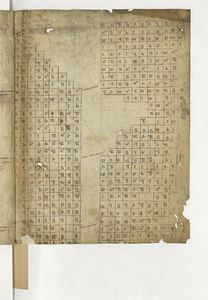Difference between revisions of "Table arithmétique – Fragment"
(→The Tables: added left col 1 table 1) |
(→Left Side, Column 1, Table 1: added table 2) |
||
| Line 33: | Line 33: | ||
===Left Side, Column 1, Table 1=== | ===Left Side, Column 1, Table 1=== | ||
| − | Multiples of 9<sup>n</sup> (n from 0 to 7) and 17<sup>n</sup> (n from 8 to 1) | + | Multiples of 9<sup>n</sup> (n from 0 to 7) and 17<sup>n</sup> (n from 8 to 1). Note that exponents of the two factors add up to 8. |
<tab class="wikitable" border = "1" cellspacing="3" cellpadding = "3" head = "top> | <tab class="wikitable" border = "1" cellspacing="3" cellpadding = "3" head = "top> | ||
| Line 45: | Line 45: | ||
1 5 3 5 8 6 4 4 9 153586449 9<sup>6</sup> x 17<sup>2</sup> | 1 5 3 5 8 6 4 4 9 153586449 9<sup>6</sup> x 17<sup>2</sup> | ||
_ 8 1 3 1 _ 4 7 3 081310473 9<sup>7</sup> x 17 SUE OCTO PARTIENT | _ 8 1 3 1 _ 4 7 3 081310473 9<sup>7</sup> x 17 SUE OCTO PARTIENT | ||
| + | </tab> | ||
| + | |||
| + | |||
| + | ===Left Side, Column 1, Table 2=== | ||
| + | |||
| + | First two roles unsolved. Then, multiples of 16<sup>n</sup> (n from 0 to 5) and 3<sup>n</sup> (n from 6 to 1). Note that exponents add up to 6. | ||
| + | |||
| + | <tab class="wikitable" border = "1" cellspacing="3" cellpadding = "3" head = "top> | ||
| + | 5 6 2 8 9 _ 6 2 5 562890625 5<sup>8</sup> x 11 x 131 | ||
| + | 3 6 6 8 7 5 . . . 366875 5<sup>4</sup> x 587 | ||
| + | 7 2 9 . . . . . . 729 3<sup>6</sup> | ||
| + | 3 8 8 8 . . . . . 3888 16 x 3<sup>5</sup> | ||
| + | 2 _ 7 3 6 . . . . 20735 16<sup>2</sup> x 3<sup>4</sup> | ||
| + | 1 1 _ 5 9 2 . . . 110592 16<sup>3</sup> x 3<sup>3</sup> | ||
| + | . 5 8 9 8 2 4 . . 589824 16<sup>4</sup> x 3<sup>2</sup> | ||
| + | . 3 1 4 5 7 2 8 . 3145728 16<sup>5</sup> x 3 SUE 7 PARTIENTES | ||
</tab> | </tab> | ||
Revision as of 20:54, 24 October 2020
Notes on the numerical tables of Table arithmétique (Fragment), Latin 9377, f. 113[1] in the Bibliothèque nationale de France (Paris).
Description of Fragment
The fragment consists of a single sheet of parchment, folded in half, with numerical tables written on both the left and right sides of the inside (flesh-side) of the parchment.
A fascimile of the pages can be viewed at [1]:
outside (reverse of left side)
outside (reverse of right side)
On the left side are 2 columns, each with 3 tables (and each with a cut off table at the bottom. On the right side are 2 columns each with 1 continuous table.
The Tables
Left Side, Column 1, Table 1
Multiples of 9n (n from 0 to 7) and 17n (n from 8 to 1). Note that exponents of the two factors add up to 8.
| -1 2 3 4 5 6 7 8 9 transcription factors note |
|---|
| 9 7 5 7 5 7 4 4 1 975757441 178 error: missing leading 6, should be 6975757441 |
| 6 9 3 _ 4 8 _ 5 7 693048057 9 x 177 error: missing leading 3, should be 3693048057 |
| 9 5 5 1 4 3 _ 8 9 955143089 92 x 176 error: missing leading 1, should be 1955143089 |
| 1 3 5 _ 7 5 7 5 3 135075753 93 x 175 error: missing a zero, should be 1035075753 |
| 5 4 7 9 8 1 2 8 1 547981281 94 x 174 |
| 2 9 _ 1 _ 7 7 3 7 290107737 95 x 173 |
| 1 5 3 5 8 6 4 4 9 153586449 96 x 172 |
| _ 8 1 3 1 _ 4 7 3 081310473 97 x 17 SUE OCTO PARTIENT |
- ↑ Note that both "9377" and "113" are prime. Coincidence?
Left Side, Column 1, Table 2
First two roles unsolved. Then, multiples of 16n (n from 0 to 5) and 3n (n from 6 to 1). Note that exponents add up to 6.
| -5 6 2 8 9 _ 6 2 5 562890625 58 x 11 x 131 |
|---|
| 3 6 6 8 7 5 . . . 366875 54 x 587 |
| 7 2 9 . . . . . . 729 36 |
| 3 8 8 8 . . . . . 3888 16 x 35 |
| 2 _ 7 3 6 . . . . 20735 162 x 34 |
| 1 1 _ 5 9 2 . . . 110592 163 x 33 |
| . 5 8 9 8 2 4 . . 589824 164 x 32 |
| . 3 1 4 5 7 2 8 . 3145728 165 x 3 SUE 7 PARTIENTES |
Background
The numbers are "apices" of early Arabic numbers.
in a table from "Histoire de la Mathematique" by J.E. Montucla, published in 1757

